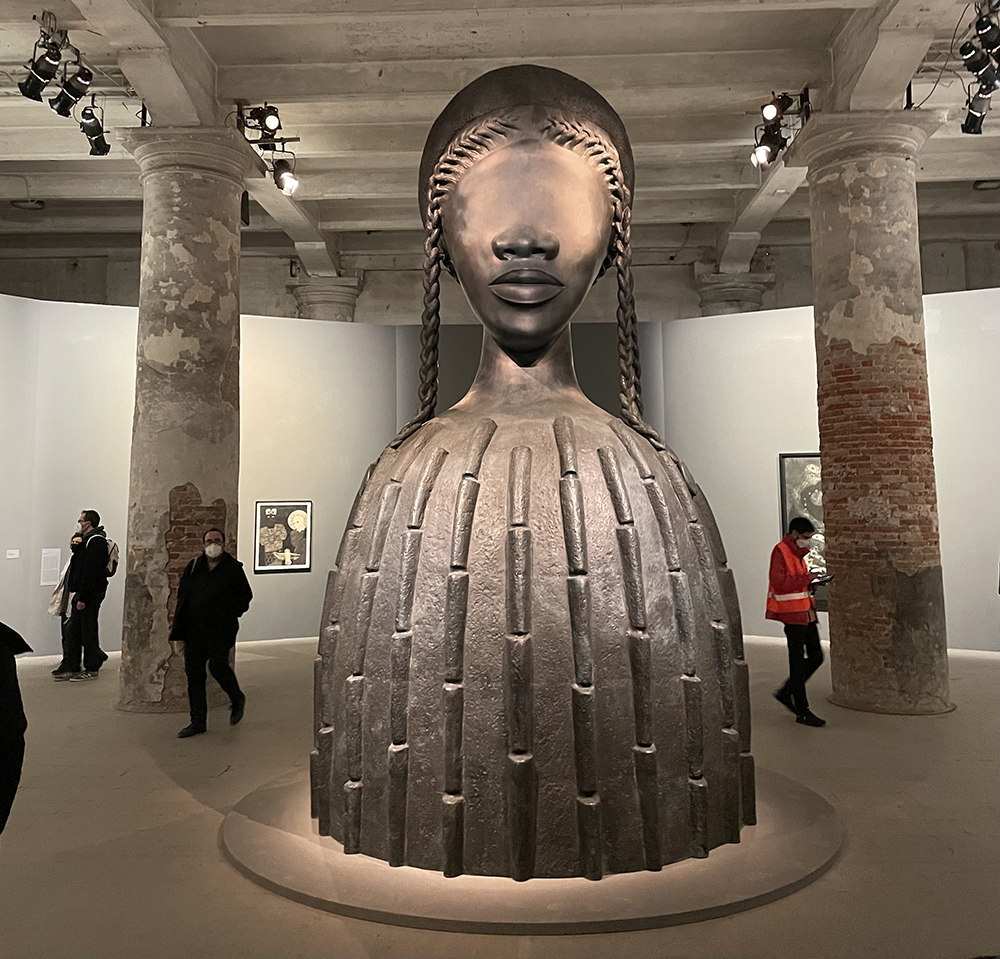Figuratively speaking, this year’s Venice Biennale is a “Brick House;” a metaphor for what creative women are capable of achieving when given the opportunity. Cecilia Alemani, the first Italian female curator since the inaugural Biennale in 1895, has included a majority of works by women and gender-nonconforming artists. Gratzie! “Milk of Dreams,” a provocation borrowed from the book by surrealist painter Leonora Carrington, symbolizes the role imagination can play in addressing humanity’s fate. The first Black woman to represent the US Pavilion, Simone Leigh, from Chicago, wins the top Biennale prize for her imposing bronze sculpture, Brick House. A female head sits atop a wide-skirted Mousgoum dwelling design; at 16-feet-high, the powerhouse archetype speaks to the Strong Black Woman schema.
Colonial oppression and its impacts on Blacks and Indigenous peoples has a violent cultural and ecological legacy. In response, the Nordic Pavilion became The Sámi Pavilion, featuring work by Indigenous artists. Standing across from the closed Russia Pavilion in the Giardini, with Italian Polizia standing guard, Sámi artist Máret Ánne Sara hung sculptures of pendulous preserved reindeer calves inside dried tundra plants, and dried inflated stomachs suspended by sinew; an extreme aesthetic for the art world, perhaps, though the Sápmi region covers the far northern parts of Norway, Sweden, Finland and Russia. Adjacent is a multi-panel mural by Anders Sunna that narrates his family’s decades-long struggle to maintain their status as forest reindeer herders. Choreographed performances at the opening in April, titled Matriarchy, by theatre director and Sámi land guardian Paulina Feodorff, involved a promenade of silent characters miming the need for listening to non-humans. Seated on tree stumps, visitors wearing headphones watched a two-channel video and listened to Sámi Elders speak of having their lands taken away, similar to the Indigenous Peoples of Turtle Island. The Sámi’s way of life, centered on their relationship with reindeer, is severely threatened because of colonial extractivism and climate change. This melancholic nature-based installation seeks to illustrate an eco-consciousness, to communicate Sámi traditional knowledge.

Turba Tol Hol-Hol Tol at the Chile Pavilion, Arsenale, Venice, Italy. Photo by Patricia Watts
To enter the Chile Pavilion at the Arsenale can take a while; the immersive multimedia installation Turba Tol Hol-Hol Tol, can allow only a few people every 15 minutes. Envisioned by curator Camila Marambio as a collaborative project including artists, scientists and traditional knowledge, the title translates as “heart of the peatlands” in the language of the Indigenous Selk’nam people of Toerra del Fuego. Pavilion attendants share fragrance samples of peat moss (Sphagnum) with visitors, while waiting in line. A Selk’nam guide, completely silent, leads visitors up a ramp, over an experimental growing field, and into a circular multimedia platform. The room darkens and vivid projections appear as participants drop deep, virtually, down into a bog. Not exactly VR, though the sound effects create a sensation of falling inside the earth. The guide then returns the group back down the ramp where we learn how growing peat in labs can avoid the destruction of natural peatlands used for fuel and growing food. In response to the climate crisis, the installation presents an intriguing path forward. Peatlands are a highly efficient carbon sink and extremely vulnerable; conservation is imperative. An immersive installation with a provocative proposition, though no artist is officially named—the focus is exclusively on Peat.
Additional pavilions not to be missed in the Giardini include Brazil, where Alagoan artist Jonathas de Andrade has you enter his sensorial installation through a large sculptural ear, à la science fair. Titled With the Heart Coming Out of the Mouth, the human body is experienced in parts as emotionally charged terrain. At the Poland Pavilion, Re-enchanting the World by Roma artist Malgorzata Mirga-Tas, a luscious 360-degree floor-to-ceiling textile mural or “picture place,” captures the rich culture of itinerate life. A collateral exhibition, Ocean! What if no change is your desperate mission? by South African artist Dineo Seshee Bopape, includes a three-channel video and sound installation of moving water taken in the Solomon Islands, a mediation with clapping sounds presented at the dramatic Iglesia di San Lorenzo. One outlier, not officially included in the Biennale, is Planet B: Climate Change & the New Sublime at Palazzo Bollani, an exhibition in three acts developed by French curatorial cooperative, Radicants, including Nicolas Bourriaud. They propose that our relationship with Earth is transforming through the horrors of extreme climate events, and that the artist’s gaze, the sublime, has been altered. Fortunately, there appears to be an eco-consciousness and some simple solutions to engage with at the 59th edition of the Venice Biennale.

